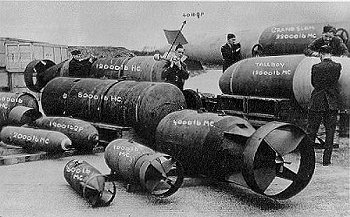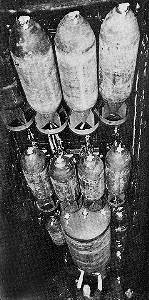Bombs:

Various bombs of different sizes used by the RAF/RCAF in WWII.

Bomb bay of Lancaster, 4000 lb. "Cookie" in place.
 Bomb bay of Lancaster fully loaded.
Bomb bay of Lancaster fully loaded.
The Cookie is surrounded by smaller aerodynamically shaped bombs. Over the
target, it was critical to release the aerodynamically shaped bombs first.
If the Cookie was released first, the aerodynamically shaped bombs could
overtake it, collide, and blow-up the bombs and aircraft in mid air.
RAF Bombs
During the years following the Great War bombs were still thought of as little
more than artillery shells dropped from airplanes.
In 1937 a new series of bombs was adopted by the RAF which were aerodynamically
shaped with tail fins, far more suited to
being carried and dropped from aircraft. These came in a variety of 'sizes'
from 40 lb bombs to 250 and 500 lb bombs. For
the first two years of the war Bomber Command relied heavily on 250 lb and
500 lb GP high explosive bombs.
Bombs were classified by their CWR (Charge-to-Weigh-Ratio) the percentage
of explosive compared to the gross weight of
the weapon. GP (General Purpose) bombs had a CWR of 30-35% meaning that most
of the weight of these bombs consisted
of metal casing not explosive. When it was realized that the weight of the
bomb casing is a necessary evil, something to be
reduced as much as possible this led to the development of new weapons such
as the 4,000 HC ('Block Buster') which greatly
increased the offensive power of RAF's bombers.
MC (Medium Capacity) bombs had a CWR of 40-50% while HC (High Capacity) weapons
had a CWR of 75-80%, the
latter being essentially explosive packed metal drums. Extensive aerodynamic
streamlining was dispensed with since these
bombs were carried internally. As already mentioned the 4,000 lb 'Block Buster'
or 'Cookie' was a very effective weapon in
this class and after its introduction rapidly became a mainstay of Bomber
Command.
GP - General Purpose CWR 30-35%
MC - Medium-Capacity CWR 40-50%
HC - High-Capacity CWR 75-80%
DP - Deep Penetration
AP - Armour Piercing
SAP - Semi-Armour Piercing
HE - High Explosive
I - Incendiary
SBC - Small Bomb Containers
TI - Target Indicator (airborne pyrotechnic stores)
PFF - Path Finder Force
RP - Rocket Projectile
A/S - Anti-Submarine
CWR - Charge-to-Weight Ratio
Nickels - Propaganda leafets dropped by air.
White Bomb - attack with propoganda leafets.
Gardening - Code-name for missions laying mines (known as cucumbers)
Various Sizes and Types of Bombs
4 lb hexagonal stick magnesium incendiary
30lb incendiary bomb
120lb GP bomb - Standard inter-war bomb, used at start of World War II
40 lb GP/HE bomb
250 lb GP/HE bomb
500 lb GP/HE bomb
500 lb MC bomb
1,000 lb MC bomb
1,900 lb GP/HE bomb
2,000 lb MC bomb
4,000 lb GP/HE bomb
4,000 lb MC bomb
4,000 lb HC bomb
4,000 lb Pink Pansy
4,000 lb Red Spot Fire
8,000 lb HC bomb
US M41 20lb Fragmentation bomb
US M34 2000lb General Purpose bomb
Red Spot Fire - 4,000 lb incendiary bomb used as a target marker
SBC - Small Bomb Containers
Each container held 236 x 4-lb or 24 x 30-lb incendiaries.
A Lancaster bomber could carry a maximum of 14 SBCs. This means that every
Lancaster over a target could dispense up to
3,304 x 4-lb (13,216 lb) or 336 x 30-lb (10,080 lb) incendiary bombs. Another
load-out for the Lancaster that is more
representative is 1 x 4,000-lb HE bomb plus 12 SBCs.
Lancasters dropped no fewer than 217,640 1,000-pound bombs between 1942 and
1945.
First use Stats:
2,000 lb HE bomb - 7 May 1940 - by Coastal Command Beaufort
2,000 lb HE/SAP bomb - 1/2 July 1940 - Bomber Command dropped Hampden, on
Kiel.
4,000 lb HE/HC ('Cookie') 'block buster' bomb - 1 April 1941 - two Wellingtons,
against Emden.
8,000 lb HE/HC bomb - 1942 - Halifax first to use weapon operationally. Early
September first 8,000 lb bombs became
availible.
250 lb TI (Target Indicating) bomb - 16/17 January 1943 - by PFF against
Berlin.
12,000 lb HE/HC bomb - 15/16 September 1943 - 617 Squadron, against Dortmund-Ems
Canal.
12,000 lb HE/DP ('Tallboy') bomb - 8/9 June 1944 - 617 Squadron, against
Saumur Tunnel.
22,000 lb HE/DP ('Grand Slam') bomb - 14 March 1945 - 617 Squadron, against
Bielefeld Viaduct.
10-11 September 1942 - 4,000 lb 'Pink Pansy' incendiary bomb used as a target
marker with a load of Benzol, rubber and
phosphorus, dropped by Bomber Command on Dusseldorf.
A "cookie" or "blockbuster" was a 4,000 pound medium capacity bomb. The RAF
"heavies" dropped large numbers of these
high-explosive bombs along with incendaries.
The RAF developed a 8,000 pound high-capacity bomb which was first used on
Feb 10, 1942.
British 30-lb incendiary bomb
British 120-lb GP bomb
Standard inter-war bomb, used at the start of World War 2
British 250-lb Middle Capacity GP bomb
Standard inter-war bomb
British 500-lb GP bomb
Standard inter-war bomb
British 500-lb Medium-Case (MC) Mk III bomb
The MC bomb proved more effective than the ealier GP bombs, due to a higher
filling:weight ratio. It was widely used by
tactical aircraft, the 500-lb type also finding applications on heavy bomeber
aircraft.
British 4,000-lb 'Cookie'
The Cookie is one of the demolition weapons employed by the RAF.
British 8,000-lb 'Cookie'
Two 4,000-lb 'Cookies' bolted together
British 12000-lb High Capacity (HC) bomb
Three 4,000-lb 'Cookies' bolted together, not to be confused with the Tallboy
deep penetration bomb.
British 12000-lb 'Tallboy' Deep Penetration Bomb
Could only be carried by the Avro Lancaster.
British 22000-lb 'Grand Slam' bomb
Could only be carried by the Avro Lancaster.
Bouncing Bomb
US M41 20-lb Fragmentation bomb
US M34 2000-lb General Purpose bomb


 Bomb bay of Lancaster fully loaded.
Bomb bay of Lancaster fully loaded.